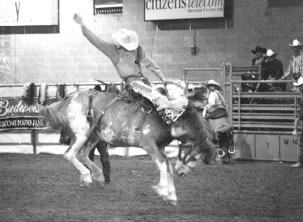Rodeo Competitions
date back to 1920s
in Grand County
by Jeff Richards
Although organized rodeo
competitions date back as early as 1872, it wasn’t
until the early 1920s that a formal rodeo or “stockmen’s
competition” was first held in Grand County, Utah.
 A bronc rider performs at the 2002
Canyonlands Rodeo.
A bronc rider performs at the 2002
Canyonlands Rodeo.
Photo by Jeff RichardsRodeo originated in the
West in the 1860s and 1870s, when cowboys on cattle drives
would often hold informal competitions, usually at the
end of a long day on the trail. The term “rodeo” is
derived from the Spanish word rodear, meaning “to
surround.” Between 1890 and 1910, traveling Wild
West shows has become a popular form of entertainment,
and rodeo events became part of Fourth of July celebrations
and county fairs around the United States. However, standardized
events, judging, and official rules didn’t yet exist
(the Rodeo Association of America, the first formal rodeo
organization, wasn’t founded until 1929, with the
Cowboys Turtle Association–later called the Professional
Cowboys Rodeo Association–following in 1936).
Grand County, which had since at least 1904 talked of having its own
county fair, finally managed to pull one off in 1922. However, rodeo
events apparently weren’t added to the fair’s schedule
until its third year.
Back in 1919, organizers had tried to put together a stockmen’s
competition in Grand County. However, the event, which was originally
scheduled for Nov. 25-27, 1919, was canceled on account of rain and
snowfall. “The First Annual Stockmen’s Carnival has passed
to its final resting place without so much as a single bronco twisting
exhibition or a horse race,” lamented the Nov. 27 issue of Moab’s
weekly community newspaper, the Grand Valley Times (later The Times-Independent).
The following year, on Sept. 2, 1920, the Times proclaimed: “Moab
will have a big stockmen’s celebration this fall, probably in
October, if the plans of a large number of local people are carried
out.” According to the article, “the plan is to hold a
number of high class racing events, offering prizes which will attract
horses from all over this section of the country. There will also be
bronco riding, steer roping, and other cowboys’ sports.” However,
it appears that this idea also fell through, as there is no record
of the event happening in the pages of the newspaper that year.
Then, in March, 1921, the beginnings of what would become the first
Grand County Fair were set in motion when F.M. Young, the principal
of the local high school, wrote a letter to the editor urging residents
to show their support for a county fair by beginning to plan for it. “If
the fair is to be given, preparations must be commenced at once,” his
letter noted.
In September of 1921, the Moab Chamber of Commerce appointed a committee
to organize a county fair in the fall of 1922. Young noted that a small
community celebration had taken place a week earlier with only a few
days of preparation, but he declared it to be a “highly successful” event
and “the beginning of something bigger and better.”
The ensuing year-long preparations paid off the following autumn, when
the first-ever Grand County Fair was held Oct. 13-14, 1922. Encouraged
by the fair’s success, organizers added more events and activities
for the following year’s event, held Oct. 12-13, 1923. “Although
the program will not include horse racing and rodeo events, it will
nevertheless provide plenty of excitement and entertainment for the
fair visitors,” said the newspaper almost apologetically on Sept.
20, 1923.
The following year, in 1924, the third annual Grand County Fair was
held in late September. “The school athletic field was used as
the fair grounds, and the new circular track, grandstand and judges’ stand
made it possible to conduct a program of races and rodeo events surpassing
anything ever before witnessed at Moab,” declared the Oct. 2,
1924 issue of the Times. “The track, while somewhat soft, was
in every way satisfactory, and several dozen thrilling races were staged
during the three day program.”
The following year (Sept. 25-26, 1925) even more events were added,
with cash prizes for each race (ranging from $10 to $75 for the first-place
finisher). In addition to horse races, there were mule races, a “potato
race,” several footraces and relays, and even a “3-mile
Ford Car Race.” In the rodeo category, cash prizes were awarded
for “best bucking horse” ($10) and “best rider” ($40).
Commented the newspaper the week after the 1925 fair: “The horsemen
and riders who furnished the entertainment were a bunch of real sportsmen.
They were ready to enter any event called and they gave the best they
had, all the time. They made many friends by their sportsmanlike conduct.”
“Albert Maxwell of Moab is a regular rodeo performer,” added the
article in the Oct. 1, 1925 issue of the Times. “Mr. Maxwell got away with
the lion’s share of the money in the cowboy events, winning first place
in the bed race, the cowboy relay, two free-for-all relays and the potato race–in
fact, every event in which he entered.”
In the 1950s, the Rodeo Grounds were at what is now Moab City Park
(Swanny Park) on 100 West and 400 North.
Nowadays, rodeo is as popular a sport as it has ever been, especially
in the United States and Canada, where more than 2,000 rodeos are held
each year, attended by millions of spectators. Larger events like the
National Finals Rodeo in Las Vegas are televised. Modern-day rodeos
consist of five standardized events, including but not limited to the
following: bareback riding, steer wrestling, team roping, saddle bronc
riding, calf roping, and bull riding. Many rodeos also include women’s
barrel racing.
This month, Grand County residents will once again get a chance to
enjoy the annual Butch Cassidy Days Canyonlands Rodeo, a PRCA tour
event, scheduled for June 10-12 (8 to 10 p.m. each night) at the Old
Spanish Trail Arena (3641 South Highway 191).

